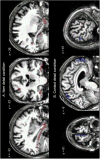Associative memory and its cerebral correlates in Alzheimer׳s disease: evidence for distinct deficits of relational and conjunctive memory
- PMID: 25172390
- PMCID: PMC4194129
- DOI: 10.1016/j.neuropsychologia.2014.08.023
Associative memory and its cerebral correlates in Alzheimer׳s disease: evidence for distinct deficits of relational and conjunctive memory
Abstract
This study investigated the impact of Alzheimer׳s disease (AD) on conjunctive and relational binding in episodic memory. Mild AD patients and controls had to remember item-color associations by imagining color either as a contextual association (relational memory) or as a feature of the item to be encoded (conjunctive memory). Patients׳ performance in each condition was correlated with cerebral metabolism measured by FDG-PET. The results showed that AD patients had an impaired capacity to remember item-color associations, with deficits in both relational and conjunctive memory. However, performance in the two kinds of associative memory varied independently across patients. Partial Least Square analyses revealed that poor conjunctive memory was related to hypometabolism in an anterior temporal-posterior fusiform brain network, whereas relational memory correlated with metabolism in regions of the default mode network. These findings support the hypothesis of distinct neural systems specialized in different types of associative memory and point to heterogeneous profiles of memory alteration in Alzheimer׳s disease as a function of damage to the respective neural networks.
Keywords: Alzheimer׳s disease; Associative memory; Binding; FDG-PET.
Copyright © 2014 Elsevier Ltd. All rights reserved.
Conflict of interest statement
Conflict of interest: The authors declare no conflict of interest.
Figures

References
-
- Algarabel S, Escudero J, Mazon JF, Pitarque A, Fuentes M, Peset V, Lacruz L. Familiarity-based recognition in the young, healthy elderly, mild cognitive impaired and Alzheimer's patients. Neuropsychologia. 2009;47:2056–2064. - PubMed
-
- Algarabel S, Fuentes M, Escudero J, Pitarque A, Peset V, Mazon JF, Meléndez JC. Recognition memory deficits in mild cognitive impairment. Aging, Neuropsychology, and Cognition. 2012;19(5):608–619. - PubMed
-
- Anderson ND, Ebert PL, Jennings JM, Grady CL, Cabeza R, Graham SJ. Recollection- and familiarity-based memory in healthy aging and amnestic mild cognitive impairment. Neuropsychology. 2008;22(2):177–187. - PubMed
Publication types
MeSH terms
Substances
Grants and funding
LinkOut - more resources
Full Text Sources
Other Literature Sources
Medical

